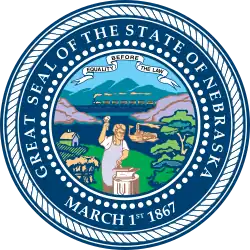Nebraska Senate
Nebraska Senate | |
|---|---|
| Nebraska Legislature | |
 | |
| Type | |
| Type | |
| History | |
| Established | 1854 |
| Disbanded | 1936 |
| Succeeded by | Nebraska Legislature |
| Leadership | |
First Territorial President | Joseph L. Sharp |
First President | |
| Structure | |
| Seats | 13 (1854–1875) 30 (1876–1880) 33 (1881–1936) |
Length of term | 2 years |
| Authority | Article III, Nebraska Constitution (pre-1936) |
| Salary | $800/year (1936) |
| Meeting place | |
| East Chamber, Nebraska State Capitol Omaha (1854–1867) Lincoln (1867–1936) | |
The Nebraska Senate was the upper house of the Nebraska Legislature during the days when Nebraska was a territory from 1854 to 1867 (when it was called the Nebraska Territorial Council) and then again when Nebraska was a state from 1867 until 1936.[1] In 1934, Nebraska voters amended the Nebraska Constitution to reconfigure the Nebraska Legislature to a unicameral system.[1] This system became effective for the 1937 legislative session. Beginning as a territorial upper house in 1854, it had 13 members; this number was raised to 30 members when the second state constitution was adopted in 1875. In 1881, the Senate increased to 33 members, and although a later constitutional amendment allowed it to increase to 50 members, it remained at 33 members until it was abolished in 1936.[1] The last senators of the bicameral legislature were elected to a two-year term in 1934 and began their service with the final legislative session in 1935.[2]
References
- ^ a b c The Nebraska Blue Book 1936 (PDF), Nebraska Legislative Reference Bureau, December 1936, p. 164-166, retrieved December 26, 2022
- ^ "Nebraska Blue Book 2020-21" (PDF), Nebraska Legislature, pp. 264–268, 2021